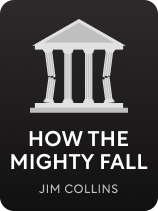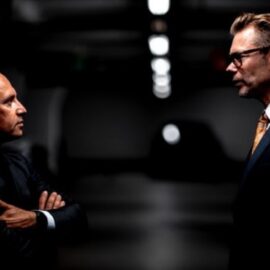
What’s the negative impact of change in an organization? What happens when leaders make rash, emotional decisions?
Sometimes, change can be great for an organization. Other times though, abrupt change could be a sign of leaders desperately trying to save a failing business.
Let’s look at the negative impact of change in an organization, including bringing new people in and implementing new strategies.
Overcorrecting in Business
Leaders of failing businesses eventually have to face reality when the situation gets noticeably worse. What some leaders do, though, ends up hurting the business more. How the Mighty Fall by Jim Collins writes that leaders can no longer deny that the company is in trouble, and they scramble for a quick way to stop the decline. Collins explains that this reaction is borne out of instinct—we make desperate moves when we’re fighting to survive, and the result is the negative impact of change in an organization.
(Shortform note: In the business world, we’re supposed to react rationally instead of emotionally, but evolutionary psychologists explain that we’re hardwired to react with emotions first. To keep from being caught off-guard and reacting in desperation in the context of a failing company, consider developing an infinite mindset. In The Infinite Game, Simon Sinek writes that those with an infinite mindset view business as constantly evolving, with known and unknown players and changeable rules. This means you should be prepared to pivot on a fundamental, existential level in anticipation of disruptive change.)
Collins writes that in this phase, companies pin their hopes on a savior. This may come in the form of an outsider who’s brought in to fix things or an overhaul of the company’s approach to business.
New People
The company might hire consultants or, with much fanfare, bring in a maverick chief executive from the outside, with the hope that new blood will bring fresh ideas to reinvigorate the company. However, Collins argues that hiring an outsider rarely works out. (Shortform note: In Built to Last, Collins explains why hiring outsider CEOs rarely works: The new CEO typically lacks a true understanding of the company’s core values and purpose and thus may steer the company in a damaging direction. For example, when Charles Pearce took over Colgate, he was obsessed with expansion and ignored the company’s philosophy of dealing fairly with retailers. This soured the company’s relationship with retailers, and Colgate’s average profits dropped by more than half.)
New Strategy
Another quick fix that a company might attempt is changing its strategy. It might go through another round of restructuring, implement a culture makeover, launch a buzzy new product, or make a hasty acquisition. If all else fails, a company might pin its hopes on a buyout. (Shortform note: Part of the reason implementing a new strategy often fails to save the company is that employees resist the change. This resistance may come from a change in “personal compacts,” or the explicit and implied agreements between the company and its employees. When a company doesn’t explain how a new strategy will affect employees’ tasks and career trajectory, employees may not deliver the results that the company expects from them.)
Often, a company’s dubious rescuer is a combination of people and strategy. Collins gives the example of Hewlett-Packard (HP), which went through a rough patch in the late ’90s. To turn things around, the company tapped Carly Fiorina to be its CEO. Collins characterizes Fiorina as a media darling who made sweeping changes to the company, including coming up with a bold new vision for HP, restructuring, and making a major acquisition. After HP performed poorly during her six-year tenure, Fiorina was fired.
(Shortform note: Some analysts characterize Fiorina as being all vision and no execution—she touted HP’s new vision while delegating the work of bringing it to fruition to a weak senior team. She had a dazzling presence, but she didn’t make an effort to connect with people, and her leadership style didn’t jive with HP’s culture. Professors from top business schools thought her performance was so poor that they included her in a list of the worst American CEOs of all time. After her exit from HP, Fiorina explored other areas outside of the executive suite: She published an autobiography, served as a business commentator for Fox News, and campaigned for the 2016 Republican presidential nomination.)

———End of Preview———
Like what you just read? Read the rest of the world's best book summary and analysis of Jim Collins's "How the Mighty Fall" at Shortform.
Here's what you'll find in our full How the Mighty Fall summary:
- How formidable companies can lose their footing and fall
- The five phases that lead to a company's downfall
- How to rechart your course if you're facing the threat of failure






